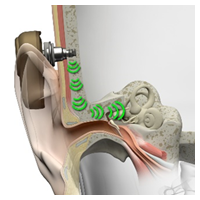A bone anchored hearing system is an alternative option to conventional hearing aids. This implant takes advantage of bone conduction – transmitting sound directly to the cochlea, bypassing the outer ear and middle ear.
How does a bone anchored hearing system (BAHS) work?

A bone anchored hearing system is worn on the head and not in the ear. It consists of a small implant and an abutment that is placed in the skull bone just behind the ear, and a sound processor that attaches to the abutment. The sound processor transmits sound by conduction through bone into the cochlea instead of transmitting sound via air conduction. In this way, bone anchored hearing systems use both the body’s natural ability to conduct sound as well as its ability to osseointegrate, and thus secures the implant.
Who can benefit from a bone-anchored hearing system?
Candidacy is best determined by a hearing care expert. There are different types of hearing loss that may benefit from a bone anchored hearing system:
Conductive hearing loss
Conductive hearing loss is when an obstruction somewhere in the outer and/or middle ear hinders airborne sound waves from reaching the inner ear.
Mixed hearing loss
Mixed hearing loss refers to a combination of conductive and sensorineural hearing loss. This means there may be challenges in both the outer or middle ear and in the inner ear.
Single-sided deafness
If you have a profound hearing loss in one ear and normal hearing in the other, you may benefit from a bone anchored hearing system, as it will enable you to hear people speaking from your poorer hearing side and may give you a better ability to hear speech in noise.
If you have conductive or mixed hearing loss, a bone anchored hearing system may be a good alternative to a conventional hearing aid as the sound signal is sent directly to the inner ear. This bypasses any blockage in the outer and middle ear, which improves sound quality. Furthermore, leaving the ear canal open helps if you suffer from ear infections or need your ears drained.
Try before you decide
If you are a potential candidate for a bone anchored hearing system, the sound processor can be tested on a soft band before committing to have the implant surgery. The sound processor should be tried in different daily situations to get an idea of what you will be able to hear.
What happens during surgery?
During the surgical procedure, an ear-nose-throat surgeon will place a small titanium implant into the mastoid bone behind the ear. This is normally a straightforward and minimally invasive surgical procedure. The dressing is removed from the implant site after 7 – 10 days post-surgery. Once the implant is fully integrated with the bone, the sound processor is fitted by an implant audiologist.
How do I know if a bone anchored hearing system is right for me?
If you have never had your hearing tested before, the first step is to get your hearing checked at your local Audika clinic. Or, if you are currently wearing hearing aids and would like to know more, your hearing care expert can check your hearing and discuss your individual hearing needs, to see if you could benefit from a referral to an implant clinic through our Specialist Referral Network.
At Audika, we have established the Specialist Referral Network to help improve access to implantable technology, like the bone anchored hearing system. Learn more about this collaboration below.





